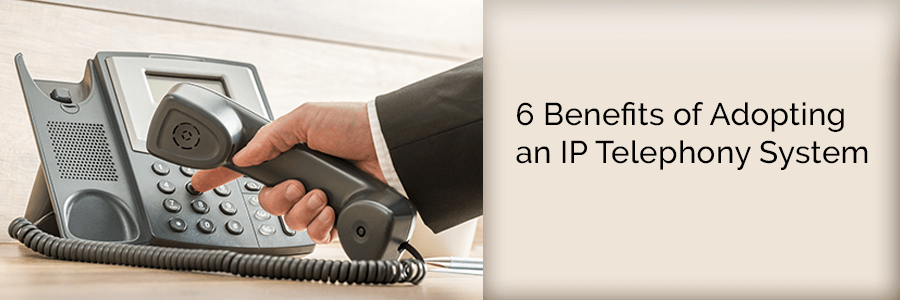Are You Reconsidering Your Enterprise Phone Service?
If you’re still using POTS, or Plain Old Telephone Service, to service your PBX (private branch exchange) system, you’re missing out on the faster speeds, multimedia streaming quality, mobility, and lower costs that a true IP telephony system solution can offer your enterprise. Enterprises of all sizes are moving towards IP telephony systems (internet protocol telephony). Research shows that enterprises who move towards IP and VoIP systems can save up to 90% on their telephone costs. AT&T, Google, Facebook, and other telecommunication, SaaS, and application providers are all moving towards IP and VoIP as the de facto standard for transmitting data. Cloud Telephony is not a consideration for many enterprise clients today due to the higher cost over a period of time, security concerns, and lower customer satisfaction.
6 Reasons Companies are Adopting an IP Telephony System
As the market share and usability of POTS continues to decline, you can put your enterprise and its business processes ahead of the curve by exploring the benefits of adopting an IP Telephony system.
1. Phones as a Service
Unlike the hardwired configuration of a POTS based PBX with T-1 line integration, IP telephony systems are essentially SaaS deployments. This allows you to integrate your phone system with other powerful business applications such as customer databases, integrated email, and even SMS operations. IP technology gives employees and customers the tools they need to interact more efficiently with each other, leading to greater business outcomes and improved customer satisfaction.
2. Mobility and Scalability
If remote offices are a consideration for your enterprise, IP telephony solutions are a must have. Instead of installing multiple physical phone systems, you can simply log in to your system’s web interface and add another line. Without the need for telephone hardware, your remote offices can go fully mobile in a matter of seconds. Enterprises can scale their communications up and down with an IP solution.
3. Integration with Current Infrastructure
IP telephone systems can also easily integrate with existing legacy systems and hardware including fax machines, alarms, and credit card readers. Because IP telephones integrate with your business applications, so will your legacy systems. When faxes are required, you can send and receive your faxes via email. When you need to transmit credit card data, you’ll see improved speeds through a network connected phone system. IP systems keep almost everything the same while increasing the functionality and productivity within your key business processes.
4. The Transmission of Multimedia Content
IP telephone systems offer more than voice-to-voice connections. In fact, IP telephone systems are equipped to handle conference calls, video calls, and other meetings where the simultaneous streaming of audio and video are crucial. POTS and legacy PBX systems cannot handle the modern needs of global enterprises that conduct business across state and country borders. A comprehensive IP telephone system eliminates software and hardware redundancy by consolidating all these conferencing necessities into one solution.
5. Good on Data, Great on Bandwidth
One of the biggest questions enterprises have about adopting an IP telephony system is how it will impact their data usage and bandwidth. And for good reason. A study by the University of West showed that 35% to 50% of a phone conversation is spent in silence. This eats up precious bandwidth that other business units may need. However, modern IP systems use VAD, or voice activation detection, to compress silent data as much as possible. During times of silence, your IP system is looking out for total bandwidth allocation, making voice-to-voice calls efficient uses of data.
6. Significantly Lower Costs
Everything about upgrading to IP telephony solution boils down to lower costs.
Installation and maintenance of an IP system can be done through in-house network engineers, or through a business partner, if you don’t want the responsibility to hire, and manage this. IP systems don’t require proprietary hardware or feature updates, either. Traditional T-1 lines require enterprise organizations to pay for a channel, even when it’s not in use. With SIP (session initiation protocol) trunking, you only pay for the data you use. And it’s through SIP trunking that you gain audio, video, and private teleconferencing features without needing to pay for extra channels.
You’ll also be able to make international and long distance phone calls at a fraction of the price associated with POTS usage. In fact, long distance and international phone calls account for almost half the estimated costs for enterprises currently using VoIP.
How Altura Can Help
Altura will analyze your current PBX architecture and assist you in deploying an IP telephony solution that gives you a competitive edge today while giving you the tools needed to scale for tomorrow. Contact us to begin your upgrade to an IP system today.





Comments are closed.